The most and latest wireless communication use electromagnetic airwaves either infrared or radio frequency to communicate information from one point wireless communication networks to another wireless communication networks Point. Without relaying on a physical connection. Radio waves are often referred to as radio carriers because they simply perform the function of delivering energy to a remote receiver.
The data being transmitted is superimposed on the radio carrier so that it can be accurately extracted at the receiving end. Multiple radio carriers can exist in the same space at the same time without interfering with each other if the radio waves are transmitted on different radio frequencies.
In a typical WLAN configuration, a transmitter/receiver (transceiver) device, called an Access Point (AP), connects to the wired network from a fixed location using standard Ethernet cable. The Access Point receives, buffers, and transmits data between the WLAN and the wired network infrastructures. A single Access Point can support a small group of users and can function within a range of less than one hundred to several hundred feet.
The Access Point (or the antenna attached to the Access Point) is usually mounted high but may be mounted essentially anywhere that is practical as long as the desired radio coverage is obtained. The wireless network, printers or other peripherals can be shared through a connected PC. The devices then communicate using a set of reserved high-frequency radio waves. An Access Point device connects to a DSL or cable modem and enables high-rate (broadband) Internet access for the entire network.
Wireless LANs have become popular in the home due to ease of installation, and in commercial complexes offering wireless access to their customers; often for free. Large wireless network projects are being put up in many major cities.
Wireless networks are based on the IEEE 802.11 standards. A basic wireless network consists of multiple stations communicating with radios that broadcast in either the 2.4GHz or 5GHz band (though this varies according to the locale and is also changing to enable communication in the 2.3 GHz and 4.9 GHz ranges).
When possible, place your wireless router, wireless modem router (a DSL or cable modem with a built-in wireless router), or wireless access point (WAP) in a central location in your home. If your wireless router, modem router, or access point is against an outside wall of your home, the signal will be weak on the other side of your home.
If your router is on the first floor and your PC or laptop is on the second floor, place the router high on a shelf in the room where it is located. Don’t worry if you can’t move your wireless router, because there are many other ways to improve your connection.
Wireless Operating Mode
The IEEE 802.11 standards specify two operating modes: infrastructure mode and ad hoc mode.
Infrastructure mode is used to connect computers with wireless network adapters, also known as wireless clients, to an existing wired network with the help from wireless router or access point. The 2 examples which I specified above operate in this mode.
Ad hoc mode is used to connect wireless clients directly together, without the need for a wireless router or access point. An ad hoc network consists of up to 9 wireless clients, which send their data directly to each other. Click here to learn more on this ad hoc mode.
We’ll be covering the following topics in this tutorial:
Type of Wireless Communication
Radiowaves Transmission
- The radio waves have frequencies between 3 GHz and 1GHz.
- Radiowaves are omni directional i.e. they travel in all the directions from the source. Because of this property, transmitter and receiver need not to be aligned.
- Radiowaves can penetrate buildings easily, so they are widely use for communication both indoors outdoors.
- The properties of radio waves are frequency dependent at low frequencies, radiowaves pass through obstacles.
- The power falls off sharply with distance (r) from sources, roughly as 1/r2 in air
- At high frequencies, radiowaves tends to travel in straight line and bounces off the obstacles.
- They are also absorbed by rain.
- At all frequencies, radiowaves are subject to interference from motors and other electrical equipments.
- In VLF, LF and MF bands, radiowaves follow the ground.
- In HF and VHF bands, ground waves are absorbed by earth. In these bands or frequencies, radiowaves are radiated upward into ionosphere where they are reflected back to earth as shown in the fig.
- Radiowaves are widely used for AM and FM radio, television, cordless telephone, cellular phones, paging and wireless LAN.
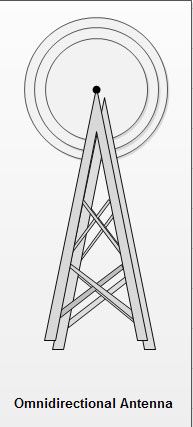
Microwave Transmission
- Microwaves are electromagnetic waves having frequencies between 1GHz and 300 GHz.
- There are two types of microwave data communication systems: Terrestrial and satellite.
Terrestrial Microwave System
- Microwaves are unidirectional i.e. they travel only in straight line from the source. Therefore repeaters are required to strengthen the signal.
- Microwaves require line-of-sight propagation
- The distance covered by a line of sight signal depends to a large extent on the height of the antenna. Therefore taller antennas allow signal to travel long distance without being stopped by the curvature of earth. In this way they are able to cross high hills, tall buildings etc. on the way.
- However, at very high frequencies, microwaves are not able to penetrate into walls.
- The microwave band is relatively wide, almost 299 GHz. Therefore wider sub bands and higher data rates are possible.
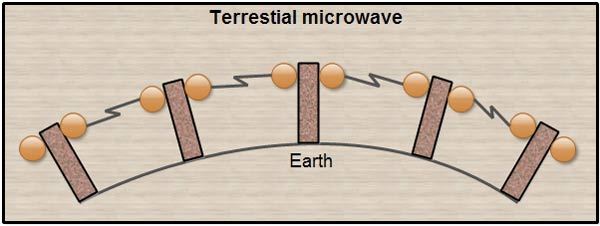
- Since microwave signals travel in one direction at a time, two microwave frequencies are required for two-way communication such as telephone conversation. One frequency is reserved for microwave transmission in one direction and the other for transmission in other direction.
- Each frequency requires its own transmitter and receiver. Now days a device called Transceivers are used which are capable of both transmitting and receiving the signals.
- Microwaves are widely used for one to one communication (unicast communication) between sender and receiver, cellular phones, satellite networks and in wireless LANs.
Infrared Waves
- Electromagnetic waves having frequencies from 300 GHz to 400 THz are called IR waves or Infrared waves.
- IR waves are used for short range communication and use line-of-sight propagation
- Infrared waves cannot pass through solid objects, like walls and can be easily contained in a room.
- Because of this property, IR waves can be used with much reduced interference. It is also possible to reuse same frequency bands in different rooms
- They are cheap, easy to build and do not require any government license to use them.
- Security system of IR systems against eavesdropping is better than that of radiowaves as they cannot pass through walls.
- IR waves offer very large bandwidth for use.
- The fact that IR waves cannot penetrate walls is its disadvantage for long distance communication.
- Infrared waves cannot be used outside a building for communicational purposes since sun’s rays contain infrared waves that can interfere with the communication.
- The most common application of IR waves is remote controls used for TV, DVD players and stereo system.
- IR waves can also be used for communication between keyboards, Douse PCs, printers with PCs.
Laser Transmission
- This type of transmission uses thin laser beams to transfer data upto few kilometers.
- Laser beams are unidirectional; therefore this type of transmission system uses line-of-sight propagation.
- In such a transmission system, a photo detector and laser is set up on both sender and receiver side.
- Such a system offers very high bandwidth at a very low cost.
- The major problem in this transmission system is that laser beams cannot penetrate rain or thick fog.
- Other disadvantage is that on hot sunny days these waves are affected by hot turbulent air and miss the detector.
- The common application of laser transmission system is the connection between two LANs operating in two separate buildings. In such a system lasers are mounted on the rooftop of buildings.
 Satellite Transmission
Satellite Transmission
- A satellite is a body that revolves around the earth just in same way earth revolves around the sun.
- A satellite can be natural such as moon or it can be artificial/man made (created by human)
- Man made satellites are widely being used for communication purposes as they cover maximum area on the earth for a particular transmission.
- The paths in which satellites move are called orbits. The orbit can be equatorial, inclined or polar.
- The period of a satellite, i.e. the time required for a satellite to make a complete trip around the earth, is determined by Kepler’s law.
- Kepler’s law defines the period as a function of the distance of the satellite from the center of the earth.
- Satellites process microwaves with bi-directional antennas (line-of-sight). Therefore, the signal from a satellite is normally aimed at a specific area called the footprint. The signal power at the center of footprint is maximum. The power decreases as we move out from the footprint center.
- A communication satellite acts as a big microwave repeater in the sky.
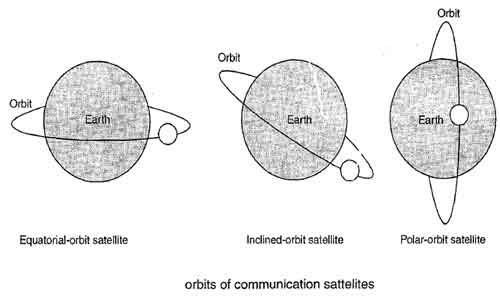
- Satellite communication makes use of geostationary satellites. A geostationary satellite is a satellite that is placed approximately 36,000 km above the equator and take exactly 24 hours to complete one revolution around the earth.
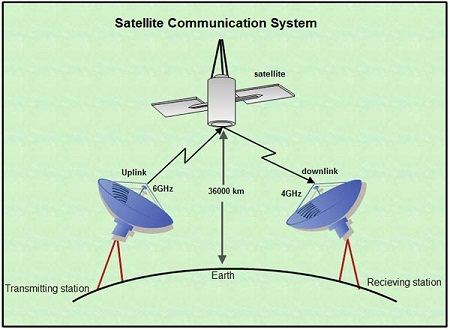
- A geostationary satellite contains several transponders. The transponder receives signal from one earth station, amplifies it and sends the signal back to other earth stations.
- A typical satellite has 12-20 transponders each with 36-50 GHz bandwidth.
- In case of satellite communication two different frequencies are used as carrier frequencies to avoid interference between incoming and outgoing signals.
- The signal which is being transmitted upwards to the satellite is called as the uplink. Thus uplink frequency is the frequency used to transmit signal from earth station to satellite.
- The signal which is being transmitted back to the receiving earth station is called as the downlink. Thus, downlink frequency is the frequency used to transmit the signal from satellite to earth station.
- Uplink and downlink frequencies are always different so as to avoid interference between them.
- There are three different bands of frequencies where satellites can operate:
(1) C band, also called 6/4 GHz band, is one of the oldest and most widely in use.
(2) Ku band, also called 11/14 GHz band.
(3) Ka band, called 20/30 GHz band.
- When satellites were first being deployed, they used a method called FDMA (Frequency Division Multiple Access) to divide up the satellite resources among the users. Currently TDMA (Time Division Multiple Access) is more common.
- With FDMA, all stations can transmit simultaneously but each one is allocated only a portion of the available bandwidth. With TDM each station takes turn for transmitting but when its turn comes up it can use the entire bandwidth.
- In year 1982, low cost micro stations called VSAT (Very Small Aperture Terminals) were introduced. These satellite systems arc named after thesmall antenna dishes they use. At one time the size of these antennas wasbetween 1.2 and 2.4 meters. Currently, their size is down to 18 inches.Although VSAT can operate in the C-band region, they are mostly used inthe Ku-band region.
- Satellites are used for variety of purposes as communication, remote sensing, and weather forecasting and for scientific purposes.
Categories of Satellites

Based on the location of the orbit, satellites can be divided into three categories.
1. Geo-stationary Earth Orbit (GEO)
2. Low-Earth Orbit (LEO)
3. Middle-Earth-Orbit (MEO)
- 1.GEO satellites are usually at 35,800 km above the earth’s surface.
- 2.MEO satellites are located at attitudes between 5,000 and 15,000 km.
- 3.LEO satellites are normally below an attitude of 2000 km.
- 4.There are two Van Allen belts that contain charged particles.
- 5.A satellite orbiting in one of these two belts would be totally destroyed by energetic charged particles.
GEO Satellites
- GEO satellites move around the earth at same speed as earth mores around the sun. Such a satellite is called geo-stationary.
- This ensures constant communication and the satellite seems to remain fixed above a certain spot.
- As the orbital speed depends on the distance from the planet, only one orbit can be geo-stationary.
- Because of the curvature of the earth one geo-stationary satellite cannot cover the whole earth. In takes a minimum of three satellites equidistant from each other in geo-stationary earth orbit (GEO) to provide full global transmission.
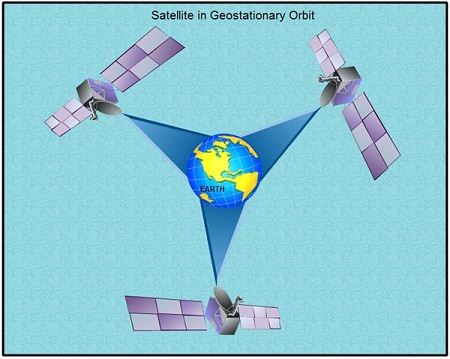
MEO Satellites
- Medium-Earth Orbit (MEO) satellite lies at lower altitudes between the two Van Allen belts.
- MEO satellites take approximately 6-8 hours to circle the earth.
- As they are at lower attitudes than GEOs, they have smaller footprint on the ground and require less powerful transmitters to reach them.
- Example of MEO satellites is Global Positioning System (GPS).
- GPS satellites orbit at about 18,000 km above the earth. GPS satellites have following features:
1. GPS is operated by US Department of Defense.
2. GPS consists of 24 satellites in 6 different orbits.
3. It is used for land, sea and air navigation to provide time and locations for vehicles and ships.
4. The orbits and the locations of the satellites in each orbit are designed in such a way, that at any time, four satellites are visible from any point on earth.
5. A GPS receiver is used that tells the current position of each satellite.
6. GPS is used by military forces to track the path and navigate vehicles and helicopters.
LEO Satellites
- Low-Earth Orbit satellites lie at an altitudes between 500 and 2000 km and have polar orbits.
- The speed of LEO satellite is 20,000 to 25,000 km/h.
- Th footprint has a diameter of 8000 km/h
- As these satellites are very close to it the ground stations do not need much power and the round trip propagation delay is less than 20 ms.
- A LEO system consists of number of satellites that work together as a network. Each satellite acts as a switch.
- LEO satellites are divided into three categories:
1. Little LEOs: operates less than 1 GHz. They are used for low-data-sate messaging.
2. Big LEOs: operates between 1 and 3 GHz. Examples of big LEOs are Globalstar and Iridium system.
3. Broadband LEOs: provide communication similar to fiber optic networks. Example is Teledesic.
Iridium
- The concept of Iridium system was started in 1990 by Motorola with 77 low orbits.
- Iridium name came from the name of the 77th chemical element.
- Later on, the plan was revised: Finally, in 1998, the service started with 66 satellites and the project was renamed Dysprosium (element 66).
- The system was halted in 1990 due to financial problems; it was resold and restarted in 2002 under new ownership.
- The 66 satellites are divided into six orbits, with 11 satellites each orbit covering entire earth.
- These satellites are at an attitude of 750 km and satellites in each orbit are separated from each other by approx. 32° of latitude.
- Each satellite has maximum of 48 cells (spot beams) with a total of (66 x 48) 3168 beams.
- However, some of the beams are turned off as the satellite approach the pole. The number of active spot beams at any moment is approximately 2000.
- In the Iridium system, communication between two users takes place through satellites. When a user calls another user, the call goes through several satellites before reaching the destination. This means relaying is done in space and each satellite needs to be sophisticated enough to do relaying.
- Iridium provides direct worldwide communication using handheld terminals. The system can be used for voice, data, paging, fax and navigation.
Global Star
- Globalstar is a LEO satellite system that uses 48 satellites.
- These 48 satellites are divided into 6 polar orbits with eight satellites in each orbit.
- These satellites are located at an attitude of 1400 km.
- The only difference between Globalstar and Iridium is the switching scheme.
- Globalstar uses a traditional bend pipe design.
- The communication between two distant users requires both satellites and earth stations. As a result ground stations can create more powerful signals.
- In Globalstar system, a call originating at a particular location is passed to satellite and is picked up by the ground station. The call is then routed via a terrestrial network to the ground station nearest the cable and is then delivered by bent pipe connection.
Teledesic
- Teledesic system was started by Craig McLaw and Bill Gates in 1990 to provide high bandwidth Internet access all over the world.
- This system of satellites provide fiber-optic like communication i.e. system with broadband channels, low error rates and low delay.
- The Teledesic system consists of 288 satellites in 12 orbits with 24 satellites in each orbit.
- The attitude of these satellites is 1350 km.
- The transmission occurs in the Ka band.
- The data rate is up to 155 Mbps for the uplink and upto 1.2 Gbps for the down link.
 Dinesh Thakur holds an B.C.A, MCDBA, MCSD certifications. Dinesh authors the hugely popular
Dinesh Thakur holds an B.C.A, MCDBA, MCSD certifications. Dinesh authors the hugely popular